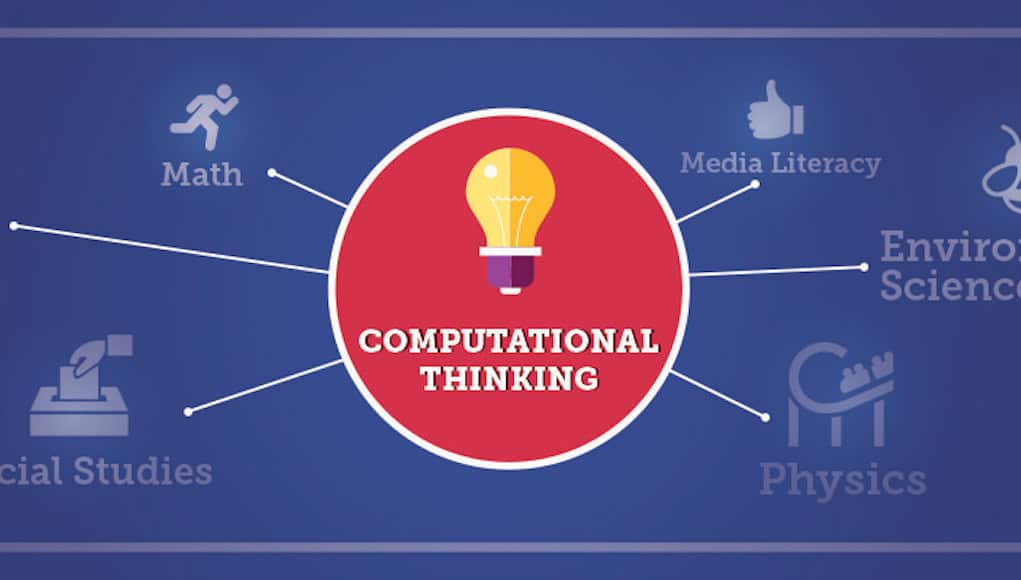Advancing Computational Thinking Across K-12 Education

By Colin Angevine
This post was originally published by Digital Promise
Thanks to the successes of campaigns like the Hour of Code and Computer Science Education Week, educators, policymakers, and families around the country are realizing the value of coding and computer science in K-12 education. But how do “code,” “computer science,” and, “computational thinking,” fit together? What is motivating their introduction into schools, and how might they change education?
Our new report, Computational Thinking for a Computational World, draws from research and interviews with leaders around the country to answer the essential question: In a computational world, what is important to know and know how to do?
The report describes how computational thinking is both central to computer science and widely applicable throughout education and the workforce. It is a skillset for solving complex problems, a way to learn topics in many disciplines, and a necessity for fully participating in a computational world.
What is Computational Thinking?
Computational thinking skills are versatile approaches to problem-solving that include:
- Gathering and organizing data to investigate questions and communicate findings
- Expressing procedures as algorithms (that is, a series of logical, precise, repeatable steps that delivers an expected result) to reliably create and analyze processes
- Creating computational models that use data and algorithms to simulate complex systems
- Using and comparing computational models to develop new insights about a subject
We see these practices of computational thinking benefitting cutting-edge research and everyday life. For example, when a hurricane is approaching, a meteorologist on TV may use a computational model to demonstrate the various paths that the storm may take as any number of interdependent variables change. An astrophysicist may similarly use computational thinking practices to develop simulations and new theories about the collisions of black holes.
Computational Thinking in Schools
The implications of computational thinking stand to impact learning across ages and disciplines in K-12 education.
Advocating for computational thinking throughout the K-12 curriculum does not replace or compete with efforts to expand computer science education: on the contrary, it complements them. Where computer science is not yet offered, integrating computational thinking into existing disciplines can empower educators and students to better understand and participate in a computational world. And schools already teaching coding and computer science will benefit from weaving computational thinking across disciplines in order to enrich and amplify lessons that are beyond the reaches of computer science classes.
We offer a number of recommendations to move this work forward. Among them are advocacy campaigns, curriculum and resource development, professional development for teachers and administrators, and continued research.
Supporting Educators to Teach Computational Thinking
Digital Promise has published 10 educator micro-credentials to support teachers as they develop the competencies to integrate computational thinking into their classrooms.
- Five micro-credentials are dedicated to the key elements of computational thinking, such as working with data, creating algorithms, and making simulations with computational models.
- Five focus on pedagogical practices for teaching computational thinking, such as creating inclusive learning environments, integrating computational thinking into existing curriculum, and assessing computational thinking.
Expertise in computer science and coding is not a prerequisite for earning a micro-credential.
The computational thinking micro-credentials benefit everyone: educators are better supported in charting their own pathways towards professional growth; schools are better able to meet new challenges of education in a computational world; and students have a better chance of engaging in computational thinking across a broad range of disciplines.
The Road Ahead
These micro-credentials are just one step towards the ambitious goal of integrating computational thinking deeply and equitably throughout K-12 education. Success entails a cultural shift in which all educators value, understand, and use the practices of computational thinking in their teaching. Achieving this will require the efforts of all sectors of the education community — not only teachers and administrators, but also families, organizations, businesses, and policymakers. But the work will be worth it; if successful, the skills students develop will be richly valuable over a lifetime.
Click here to read the full report.
For more, see:
- How Can We Bring Coding into Authentic PBL?
- All About STEM High Schools
- How The Village School Puts Coding at the Center of Their Approach
Colin Angevine is Program Manager for Maker Learning at Digital Promise.
Stay in-the-know with all things EdTech and innovations in learning by signing up to receive our weekly newsletter, Smart Update.








0 Comments
Leave a Comment
Your email address will not be published. All fields are required.